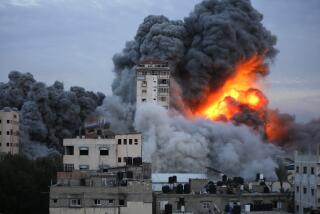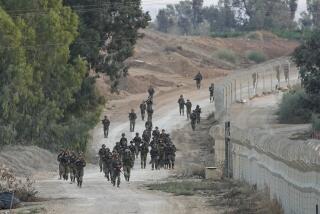Mapping the Minds in Iraq’s Regime
- Share via
WASHINGTON — When Vice President Dick Cheney said last week that the United States would “consider all possible options” in defeating Iraq, few knew one of the options was a team of social scientists and mathematicians busily trying to get inside the mind of Saddam Hussein in order to topple him from power.
At the core of this secret U.S. effort is “influence net” modeling. In essence, influence nets consist of psychological profiles of political actors and graphic depictions of their relationships. They suggest how decisions are made and implemented. In short, the nets are diagrams of who influences whom, how that influence is exerted and why. In the last decade, intelligence and military analysts have increasingly relied on such tools to support planning, targeting and operations.
The problem, says one military proponent of this approach, called “effects-based” warfare, is that “not everything that counts can be counted, and not everything that can be counted counts.” On the other hand, the scale of the U.S. effort since Sept. 11 to understand and influence the behavior of its adversaries, in particular Saddam Hussein, should give some solace to those who believe that war planning for Iraq is driven by a mindless cabal.
U.S. analysts and war planners have used influence-net modeling to assist in their decision-making since 1994. The seed was planted during the Persian Gulf War, when analysts used the concept to “map” the central points in Iraq’s air defense, communications and electrical infrastructures. Today, this “nodal” planning is being applied to human behavior.
Computerization and the availability of vast amounts of news-media material have facilitated the development of software, called “natural language processors,” that can extract relevant data on a country’s political actors. From this information, their psychological profiles are constructed and their relationships with other political figures charted. Armed with this psychological knowledge, analysts try to determine how several possible U.S. actions might affect the subjects’ behavior.
This approach works something like this. The Republican Guards are often said to be Saddam Hussein’s last-stand protectors. But analysts, monitoring communications and the interactions of the guards, have constructed influence-net models that identify certain special presidential guard units and secret police organizations as the only parties with direct access to Hussein. Hence, they are better prospective targets than other concentrations of Republican Guards if the military goal is to poke holes in the Iraqi leader’s protective screen.
Lee Wagenhals and Alexander Levis of George Mason University employ a software suite called CAESAR to tease out the beliefs and reasoning underlying military operations. CAESAR incorporates two influence-net applications: the Situational Influence Assessment Module, developed at Science Applications International Corp.; and the Campaign Assessment Tool, developed by the Air Force.
In these influence nets, “node” represents a political actor’s statement or belief. The probability that the belief or statement will play a role in a decision is given a value. Various weblike diagrams and color schemes represent the links and strengths of the actors’ relationships. If one “parental” actor (say, a very close Saddam Hussein advisor) is influenced in some way (he learns about an assassination plot targeting his boss), a “network” of cascading effects on the “children” (lesser advisors) is drawn. The network of relationships and reactions, called “branches” and “sequels” by the military, represents the behavioral implications of different U.S. actions.
CAESAR was used in 2000 and 2001 at the Naval War College during its “global” war game series. Analysts from the Office of Naval Intelligence and the Defense Intelligence Agency provided real-world intelligence about the beliefs and reasoning processes of an Iraq-like adversary, from which an influence-net model was created. A team using influence-net models tested destructive, electronic warfare and psychological actions to see if any was especially decisive in bringing about the commander’s goals. One question posed was how to force one side to back down without resorting to the use of weapons of mass destruction.
Today, the institution responsible for pulling influence-net modeling together for real-world operations is the Joint Warfare Analysis Center (JWAC), a Defense Department organization. After the Gulf War, many inside the military recognized the need to upgrade targeting science to match weaponry’s new precision. With 200 engineers, scientists and analysts, the Pentagon unit was initially assigned responsibility for targeting enemy electrical, communications, transportation and petroleum networks for precision attack. In the late 1990s, however, it was given the expanded mission of assessing the broader political, economic and social effects of alternate courses of military action.
By the Yugoslavia war in 1999, JWAC had 515 employees and a $75-million budget. The Clinton administration relied on it to predict the extent of collateral damage caused by U.S. military attacks in urban areas. But JWAC’s real innovation was computer-aided analysis that allowed the most sensitive intelligence and imagery to be merged with tens of millions of pieces of information. This information was later used to build influence-net models focusing on the behavior of leaders.
In 1999, JWAC assisted the CIA in “mapping” Yugoslav leader Slobodan Milosevic’s inner circle. Using academic models such as the Kansas Event Data System and the Protocol for the Assessment of Nonviolent Direct Action, analysts profiled the psychologies of Yugoslavia’s key decision-makers and their interactions and relationships. Other secret models--the “Arena” and “J-quad IO model”--were used to understand Yugoslavia’s command, control and computer systems. All this provided the intelligence basis for a covert strategy that, among other things, aimed to harass the Milosevic family and to disrupt its crony financial interests.
JWAC had become, in the words of one of its prominent proponents, a “national treasure,” though it is virtually unheard of outside secret military-planning circles. Defense Secretary Donald H. Rumsfeld, in recognition of the unit’s importance, has called for the Pentagon to broaden its multidisciplinary capability “to depict adversaries as complex, adaptive systems.”
By Sept. 11, JWAC was charged with replicating, then tracking, the inner workings of nine potential U.S. adversaries, among them Iraq. Since then, it has added tools to analyze Afghanistan and target terrorist networks. For Operation Enduring Freedom in Afghanistan, JWAC, using its innocuously named Research, Integration and Technology Environment capability, provided Central Command with a near-real-time picture of the leaderships of Al Qaeda and the Taliban.
While JWAC has become very good at analyzing physical infrastructure like electrical power grids, insiders question how good it is at “nonmaterial” analysis. In the case of a country like Iraq, JWAC and intelligence analysts not only try to know what Saddam Hussein actually values and how his inner circle functions, but they also want to learn how such nonmaterial factors as domestic politics, succession anxieties and dissident control affect their thinking and behavior.
“There is no guarantee that two groups of very good experts would not draw very different [influence] nets,” one participant in the global war games said. “However, if they did draw different networks, and they saw one another’s, they would have an excellent mechanism for debating.” The tools’ greatest power is in “getting people to focus on what matters.”
Rear Adm. Curtis Kemp, who commanded the “blue” forces in the war games, reviewed the usefulness of influence-net modeling in the games less than two weeks before the Sept. 11 attacks. Impressed with the tool, he said one couldn’t undertake effects-based warfare without a deep understanding of an adversary’s thinking. He lamented, nevertheless, that such modeling had not been used at the beginning of the war games to “help formulate effects and define ‘decisive’ points.” In other words, the mission and strategy were not shaped by the insights generated by the influence nets. Instead, the nets were merely tools to test the commander’s intuition and decisions.
Will the team of social scientists and mathematicians be successful in finding the key to toppling Hussein?
A military study on JWAC analysis concluded that it “is no better than the questions [it] is asked and the direction it is given.” Yet, proponents of JWAC and influence-net modeling contend that the tools themselves become important factors in military decisions. When it comes to Hussein, one high-level Air Force source says, not only is influence-net modeling useful to determine his true inner circle of advisors, but it also can track events that might presage shifts in loyalty or action against his regime.
Nerds at JWAC may not achieve regime change all by themselves. But their work should be part of the public’s understanding that war with Iraq entails more than either newfangled precision air power and special operations as applied in Afghanistan, or the traditional warfare forms that favor a grinding ground battle.
More to Read
Sign up for Essential California
The most important California stories and recommendations in your inbox every morning.
You may occasionally receive promotional content from the Los Angeles Times.







